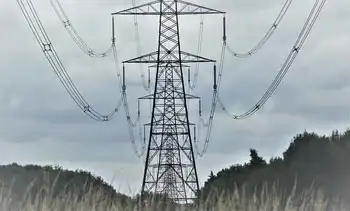Water adds new constraints to power
By New York Times
Protective Relay Training - Basic
Our customized live online or in‑person group training can be delivered to your staff at your location.

- Live Online
- 12 hours Instructor-led
- Group Training Available
They are bumping up against water scarcity.
In the United States, thermoelectric power generation — mainly coal, nuclear and natural gas — accounted for 41 percent of U.S. freshwater withdrawals in 2005, U.S. Geological Society data show.
“Typically, project developers have wanted to use water for cooling because it’s more efficient and capital costs are less,” said Terry O’Brien, the California Energy Commission’s deputy director for power plant licensing. “That makes the project more economic.”
But there is a growing awareness in California and throughout the United States that the use of water for energy generation may be reaching its limits.
California has extensive experience with water shortages, resulting in its adoption of a policy, included in the energy commissionÂ’s 2003 Integrated Energy Policy Report, that discourages freshwater use for power plant cooling. The commissionÂ’s regularly updated reports provide current data and set the parameters for state energy and conservation policies.
“It’s just not possible anymore in California, and increasingly anywhere, to find unlimited water for the old water-intensive cooling systems,” said Peter Gleick, president of the Pacific Institute, which researches water issues and advises on policy. “If you want to build a big central power plant, whether it’s oil, gas or nuclear, you can’t take the water for granted.”
In the past decade, water availability has increasingly had an effect on the reliability of power supplies in many countries, with droughts leading to temporary closings of nuclear plants in Australia, France, Germany, Romania and Spain. Similar shutdowns have been threatened in the United States.
For a thermoelectric plant, the cooling technology used is the biggest factor in its water needs.
Once-through cooling, an inexpensive, energy-efficient and therefore widely used process, sucks up huge quantities of river, lake, or sea water. A typical 500-megawatt power plant takes in almost 19 million gallons, or 72 million liters, an hour, according to a 2005 report from the U.S. Department of Energy.
After running through the plant, almost all of this is returned to the river, lake or ocean. The used water, however, may be polluted, and the heat that it has absorbed can be lethal to fish, while the intake can kill wildlife and microorganisms. Research of the environmental consequences has led to tighter regulations in recent years, making it nearly impossible to get permits for new plants using once-through cooling anywhere in the United States.
The California state water board, going further, adopted rules this month tightening environmental protection requirements for existing coastal once-through plants — a step toward phasing out the technology at 19 plants. The U.S. Environmental Protection Agency is evaluating whether to follow California’s lead.
As once-through cooling has fallen out of favor, wet cooling, which exploits the chilling effect of evaporation, has become more common. It uses only about 3 percent of the water needed for once-through cooling — but it loses 90 percent of that to vapor. Wet-cooling systems are more expensive to build than once-through and consume as much as 3 percent of the energy generated by the plant. But a point in their favor is that they can use non-freshwater sources, like wastewater or mine pools.
Recent government data show that 56 percent of U.S. thermoelectric generating capacity is now wet-cooled, against 43 percent using once-through systems.
A newer process, dry cooling, which uses fans to push waste heat into the atmosphere instead of into water, is still more expensive and less efficient. On hot days, as much as 15 percent of the energy generated by a plant may be expended on cooling, according to the Electric Power Research Institute, a research body funded by the energy industry.
The sort of cooling technology used has more of an effect on water consumption than the type of thermal generating technology, said Kent Zammit, senior program manager for the research body. “Any of these technologies — nuclear, coal, natural gas, solar thermal and biomass — will have roughly comparable water requirements for cooling.”
But for non-thermoelectric renewable energy, various technologies have very different water footprints, said Bevan Griffiths-Sattenspiel, project director for River Network, a water conservation organization. Hydropower, for example, causes large-scale water losses, mainly due to evaporation from the increased water surface area behind the dam.
And then there is the example of corn ethanol, which is used as a transportation fuel. “The biggest example of complete ignorance of water consumption is the big biofuels mandate,” Mr. Griffiths-Sattenspiel said. “It wasn’t until after it passed that people really started looking at it and considering the consequences of it. If we were to replace gasoline with biofuels, we’d be looking at a 2- to 200-times increase in water consumption for energy-related fuels,” depending on crop irrigation intensity.
Dr. Gleick, of the Pacific Institute, said: “The best alternatives from a water perspective are wind and photovoltaics, that require effectively no water. If the only thing we cared about was carbon, the problem of climate change, we would move toward nuclear and renewables. But we also have to think about water.”
Photovoltaics consume some water in manufacturing. But no one has published comparative full-cycle data on the water used in manufacturing, operating and decommissioning the various energy generating technologies.
Dr. Gleick, who has done some preliminary research, said: “The biggest water inputs come not in the manufacturing of the energy system but in the operation of the plants themselves. There’s water required to make photovoltaics, but there’s also water required to make the steel that goes into power plants, and the difference is not all that significant compared to the 30 years of operations.”
Despite the growing attention paid to water consumption, comparative costs still mainly determine construction choices. Costs, and cost estimates, vary widely and are highly sensitive to variable inputs such as raw materials, fuel and labor prices. But a study published by the U.S. governmentÂ’s Energy Information Administration in December gave a sense of the playing field.
Estimating the “levelized” full lifecycle cost of power generation at new plants to begin operations in 2016, the study put the cost at $100.40 per megawatt-hour for a conventional coal-fired plant $83.10 for a conventional combined-cycle natural gas plant $119 for nuclear $111 for biomass $149.30 for wind $256.60 for solar thermal and $396.10 for solar photovoltaic. These costs exclude potential liability for external risks such as pollution clean-up, or fines.
Nevertheless, CaliforniaÂ’s policy of discouraging the use of freshwater for power plant cooling is having an effect on that stateÂ’s power infrastructure.
Mr. O’Brien, of the energy commission, said developers were still driven by economics. “But in California we’ve sent a strong signal to power plant developers through the 2003 Integrated Energy Policy Report on water,” he said, “and we’ve seen a major change in the projects that are being proposed because of that.”
The policy has affected the developers looking to build solar thermal plants in the Mojave. “We have three applications in-house for a solar-trough technology from Solar Millennium, and they made the decision to go to dry cooling before they filed with us,” he said. Solar troughs use arrays of long parabolic mirrors to focus the sun’s rays on oil-filled pipes that capture the heat.
The solar industry is young and innovative, but it is not alone in looking for ways to reduce water requirements.
“Many natural-gas-fired power plants that the commission has approved have used reclaimed water in lieu of using freshwater,” Mr. O’Brien said, referring to water recycled from waste treatment facilities. “A few of those projects have also been dry cooled. Clearly, that’s in response to water availability issues.”
Mr. Zammit, of the Electric Power Research Institute, concurs that the availability of water, not its cost, is the limiting factor. “The cost of the water may not be that expensive, but it may be very expensive if your plant is delayed or you never can build it because of water concerns,” he said.
Water limitations are now affecting even historically wet regions, like the southeastern United States. “Ten years ago, did anyone in Georgia think that water availability would constrain their growth and development?” Dr. Gleick said. “No. But that’s certainly what’s happening today.”











